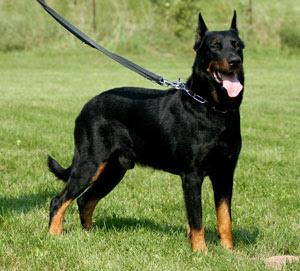Used to move large herds of sheep and cattle up to 50 miles per day, the Beauceron is a well balanced solid dog of good height and well muscled without heaviness or coarseness. Conformation gives the impression of depth and solidity without bulkiness exhibiting the strength endurance and agility of a herding dog. He is alert and energetic with a noble carriage.
A formidable dog with a frank and unwavering expression, he always demands respect wherever he goes. Dogs are characteristically larger throughout with a larger frame and heavier bone then bitches. Bitches are distinctly feminine without weakness in substance or structure. The Beauceron should be discerning and confident. He is a dog with spirit and initiative, wise and fearless with no trace of timidity. Intelligent, easily trained, faithful, gentle and obedient. The Beauceron possesses an excellent memory and an ardent desire to please his master. He retains a high degree of his inherited instinct to guard home and master. Although he can be reserved with strangers, he is loving and loyal to those he knows. Some will display a certain independence. He should be easily approached without showing signs of fear.
The Beauceron is an old and distinct French breed of herding dog, developed solely in France with no foreign crosses. Dogs were bred and selected for their aptitude to herd and guard large flocks of sheep as well as for their structure and endurance. Beaucerons were used to move herds of 200 to 300 head traveling up to 50 miles per day without showing signs of exhaustion. The ideal Beauceron is a well balanced, solid dog of good height and well muscled without heaviness or coarseness. The whole conformation gives the impression of depth and solidity without bulkiness, exhibiting the strength, endurance and agility required of the herding dog.
He is alert and energetic with a noble carriage. A formidable dog with a frank and unwavering expression, he always demands respect wherever he goes. Dogs are characteristically larger throughout with a larger frame and heavier bone than bitches. Bitches are distinctly feminine, but without weakness in substance or structure. The Beauceron should be discerning and confident. He is a dog with spirit and initiative, wise and fearless with no trace of timidity. Intelligent, easily trained, faithful, gentle and obedient. The Beauceron possesses an excellent memory and an ardent desire to please his master. He retains a high degree of his inherited instinct to guard home and master. Although he can be reserved with strangers, he is loving and loyal to those he knows. Some will display a certain independence. He should be easily approached without showing signs of fear.
Beauceron Breed History
• Old breed developed solely in France with no foreign crosses originating in the plain areas where tending, herding shepherds were used.
• In 1809, a priest, Abbe’ Rozier distinquished between two types of shepherds one for herding and one for protecting livestock against predators.
• In 1863, first dog show coinciding with the Universal Exposition in Paris in which 13 dogs of lupoid type with upright ears, black coat with rust markings were entered.
• In 1888, Pierre Megnin differentiated with precision two types of these sheepdogs one with a long coat and the other with a short coat.
• In 1896, the Club Francais du Chien de Berger was created to promote the French shepherd breeds. The short-coated shepherd dogs were called the Berger de Beauce “Beauceron” while the long coated shepherds were called the Berger de Brie “Briard.”
• In 1911, a separate club for the Berger de Beauce Les Amis du Beauceron was founded.
• Calmness and ability to follow commands without hesitation was well illustrated during both major wars in Europe to pass messages, detect mines, pick up trails, and support commandos. They are still used by the military and police.
• Today’s Beauceron excels in Herding and Guarding, Tracking, Search and Rescue, Competitive Agility and Obedience, French Ring, Schutzhund, Skijoring, Police Work, Service, and as a loyal family companion.

















0 comments:
Post a Comment